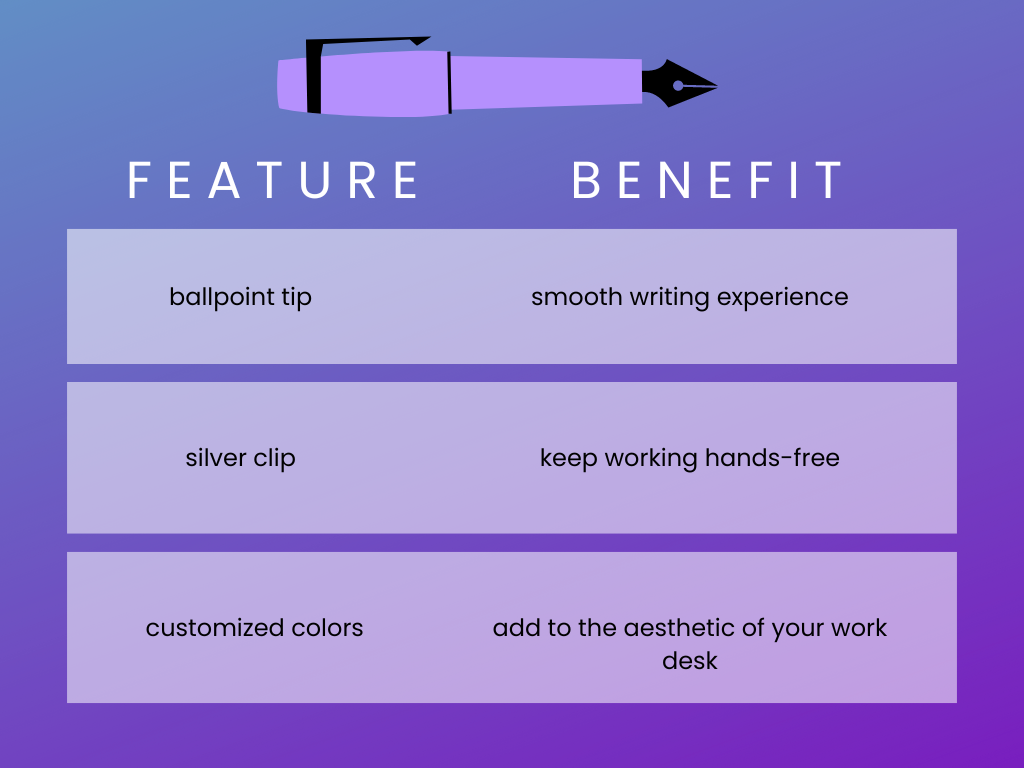Marketing starts with features and benefits
Defining features and benefits is the perfect exercise to frame your mindset, messaging, and strategy. Here’s how they set you up for success:
Features and benefits provide alignment across teams. When employees and customers speak about products with the same language, word of mouth grows consistent and powerful.
Features and benefits help you find powerful keywords. Knowing the value of your products helps you brainstorm keywords related to this value. Find buyers that are looking for solutions to the exact problems you solve.
Features and benefits help you write compelling marketing copy. Communicate with potential buyers in a way that speaks to their needs, and help them understand why your product is the best fit.
Recommended: The Guide to Product Messaging >
So how exactly do features and benefits work? Read on to learn the key differences - I’ll use plenty of examples to show you how to create your own.
What are features?
Features are key details of a product - or the “what”. They come in the form of technical specs, deliverables customers can expect, packaging, or even the expertise of people. For instance:
Comes with a mobile app
Consultants' PHDs
Certified professionals
Extra space
Sweat-wicking fabrics
What are benefits?
Benefits speak to the value generated by features. They are the “why” behind your products. Here are some examples of benefits a product may have:
Save time so you can focus on other things
Be empowered to make better decisions
Feel more confident in your exercise clothes
Example: features and benefits of a pen
How to tie features and benefits into marketing messaging
Mapping features and benefits is helpful for businesses of all sizes. In fact, I included it in the first step of inbound content marketing for start-ups.
Now let’s kick it up a notch from a pen! We’ll walk through another example of a small deli, starting with features and benefits and tying them into marketing messaging.
Features and benefits of a best-selling sandwich:
Low Price (feature) - Don’t feel guilty about eating out (benefit).
High Protein (feature) - Stay full for longer (benefit).
Locally-Grown Ingredients (feature) - Balance your health and hormones by eating fresh, organic ingredients without additives (benefit).
Now that these are solidified, it’s much easier to brainstorm ideas for ad copy or social media captions.
Marketing messaging (leading with the benefits and value):
At just $6.00, you can eat our subs every day for lunch guilt-free!
Stay full until dinner! With 30g protein, our subs are a smart option for lunch.
Enjoy fresh, local ingredients! We offer everything you want on a sub without the preservatives and chemicals you’ll find at big chains.
The importance of leading with benefits
If we can do it with a sandwich shop and pen, we can do it with your eCommerce, eLearning, or SaaS product no problem!
In these spaces, features are pretty easy to think through. They’re probably listed beside icons throughout your entire website.
Putting thought into value offered is more time-consuming, but essential! Here’s why.
Leading with features is confusing for buyers
Because we tend to think in terms of features when marketing our own products, we tend to lead with them in our messaging.
How many websites do you see listing features explained by the benefit? Here’s an example from a tech company:
Does anyone care what OTT 2.0 and Computer vision are? Do they even know what it means without researching?
Leading with benefits highlights what buyers want
Customers don’t care about how you generate value. They care more about what the value is. The core principles of their decision are going to be:
How much value is generated?
How much will it cost?
Ultimately, if the value is greater than the cost, they will purchase.
For this reason, you’ll want to highlight the benefits (or value generated) across your website. Then, use features to add credibility to these benefits.
Here’s an example of top content marketing agency Grow & Convert leading with a benefit on their course landing page:
Why are features and benefits so often ignored?
Marketers will talk about persona research and pain points all day. So rarely do you come across a feature and benefit analysis! Here’s why.
The feature and benefit step of a business is intuitively rolled into product development. When a developer begins an app or a plumber starts his business plan, they each keep their core competency and supporting details in mind.
Marketers will come in later and create messaging from core competencies and persona research. And as the product evolves over time, teams continue to skip the feature/benefit step moving forward in their content planning. Furthermore, many small teams lack product managers that are focused on this type of documentation.
The good news is, it’s not hard to make up for lost time. Try my features and benefits worksheet for guidance, or simply list your features and benefits by mirroring my examples above. Regularly completing this exercise can keep your business and product on track.
Thanks for reading! You might also like…
The Product Messaging Guide
Learn how to develop a persona-first messaging framework that converts.
The Advanced Content Marketing Guide
Learn tricks to increase your content quality and build a research-based content strategy.
















